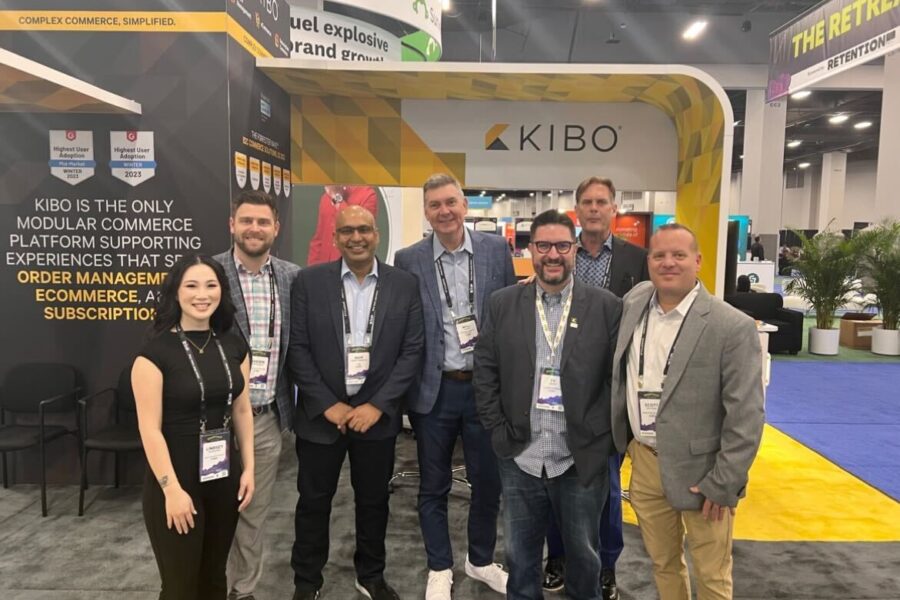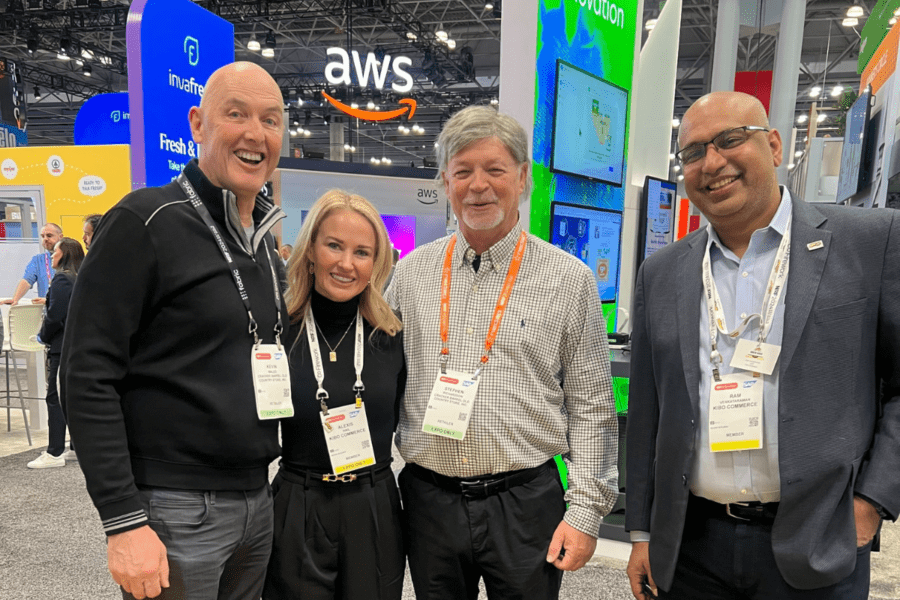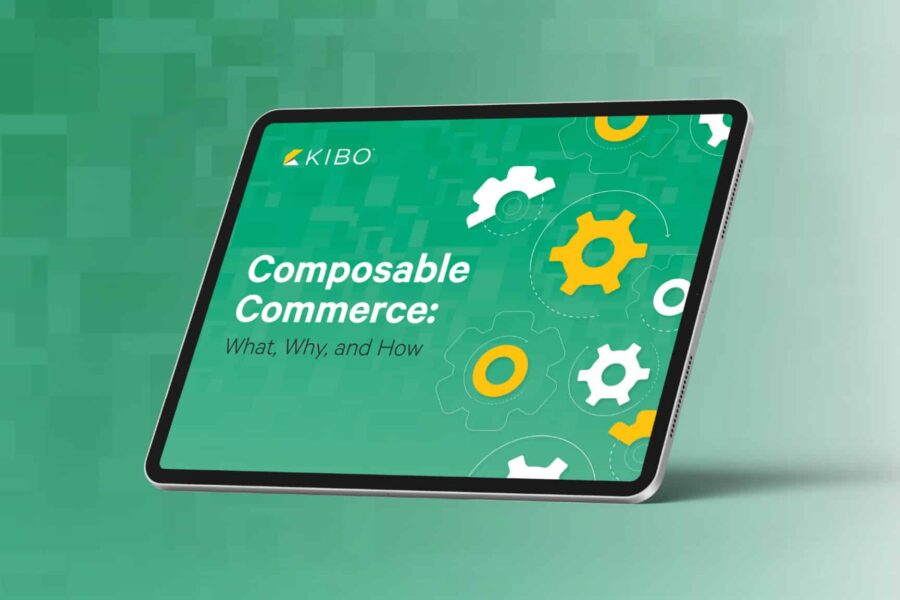To say the Kibo team was excited for NRF would be putting it lightly. For many of us, this is the first conference we’ve attended since the pandemic, and we are thrilled to be seeing our teammates, colleagues, partners, and peers in person.
NRF Retail’s Big Show is one of the largest conferences of its kind, bringing together thousands of retail professionals and leading experts to share insights and collaborate on new initiatives. As we wrap up Day 1, we’d like to share our biggest takeaways.
Leading Retailers are Adopting Composable Commerce to Deliver Seamless Brand Experiences
After years of weak performance and increasing demand from shoppers for seamless customer experiences, Molly Langenstein, Chico’s FAS CEO and President, stepped in and embarked on a three-year vision. “We diligently built a transformation strategy and re-imagined the company,” said Molly.
Part of that plan was switching to a modular, composable eCommerce solution to deliver seamless customer experiences. Chico’s has over five billion customer interactions each year, and 95% of them are digital. Not only did they need to be able to connect those touchpoints, but they also needed to ensure each touchpoint emulated the brand’s charm and character that fans have come to love.
By switching to a composable commerce solution, it’s become infinitely easier to add, test, and change customer experiences based on data rather than hunches. “We don’t know what channels or macro customer experiences will be in the next five years, so we need to be able to pivot very quickly,” said Jay Topper, Chief Digital Officer at Chico’s FAS.
Not only does composable commerce streamline the customer experience, it fosters operational excellence. Behind its product and customer, Chico’s true differentiator has become technology. By leveraging technology to streamline operations, including inventory management, fulfillment, and data unification, they’re able to meet customer expectations. It’s all about “getting the right product at the right place…when she wants something, it’s there,” said Jay.
Pivoting to a composable commerce strategy is more than building a modular system – it’s a mindset that the entire organization needs to adopt. By prioritizing change management, Chico’s was able to instill the “why” behind the transformation across the organization – building a foundation for long-term success. Since switching to a composable commerce strategy, Chico’s has had consistent double-digit growth year over year.
Physical Locations Now Play a Bigger Role in Being Digital First
Over the last decade, digital-first brands like Warby Parker and Casper have become major disruptors in their industries. But as the customer buying journey has grown more complex, these digitally born brands are recognizing the need to implement physical locations and tie them into the digital experiences.
“The only channel is the consumer,” said Dimas Gimeno, Founder and CEO of WOW Concept. WOW is striving to blend the online and offline channels by unifying data — customer shopping cart, order history, inventory, browsing history, etc. — to create connected experiences and meet the consumer where and when they want.
For the first time in recent retail history, brands are seeing that the path to growth is through physical stores. By investing in omnichannel experiences, WOW Concept has seen a cost of customer acquisition reduction, conversion increase, and better customer lifetime value.
The Power of Post-Purchase Experience
Once consumers started adopting digital channels as part of their shopping journeys, brands and retailers pivoted their investments to their eCommerce site, social channels, and online marketplaces to meet customer needs. And while many of these companies saw returns on their investments, they quickly recognized the need to focus on the post-purchase experience as well.
The Ideal Post-Purchase Experience
According to Dimple Rao, VP of Digital Product at Chico’s FAS, there are three pillars of an ideal post-purchase experience: Communication, Consistency, and Control. It’s no longer enough to know when the order was shipped or when it is estimated to arrive. “They want to know what’s happening along the way,” said Dimple. According to ParcelLabs, the ideal number of communications with the customer during the post-purchase experience is seven.
The Future of Delivery and Fulfillment
Delivering a frictionless post-purchase experience requires modular, flexible technology that can adapt as consumer expectations change. For example, to provide accurate delivery dates, you need a modern inventory and order management system that can unify inventory data in real-time and fulfill orders based on custom rules and configurations — this allows retailers to set realistic expectations and deliver orders quickly and efficiently.
How Supply Chain, Economic Uncertainty, and Rapidly Shifting Consumer Behaviors are Affecting Retailers
During a fireside chat, Shira Yoskovitch, VP of Corporate Development & Transformation at SCI Group, and Chadwick Hamby, VP of IT at Pet Supermarket, shared their experiences as they navigate the hurdles of supply chain, economic uncertainty, and rapidly changing consumer behaviors.
How are businesses dealing with economic uncertainty?
Inventory will be the focus as companies weather economic uncertainty. Not only do retailers need to quickly turn over inventory, but they also need to balance inventory across regions to ensure they’re meeting consumer demands and can fulfill orders efficiently.
Pet Supermarket is still largely focused on the supply chain and being able to replenish inventory and forecasting demands. The key is balancing safety stock with the cost of infrastructure to buy, store, and ship that stock.
How are roadmaps being built today?
“The notion of a three-year roadmap is gone when it comes to the day-to-day functionality you need,” said Shira. The speed of evolution is unlike anything we’ve seen before — a three-year roadmap will be outdated within 12-18 months.
As retailers build out their 12-18 month roadmaps, it’s critical to build in stopping points to evaluate what’s been done, determine if it’s working, and make any adjustments as needed.
How does the new normal affect digital transformation plans?
As companies build out their digital transformation plans, they need to be deliberate about what technologies, capabilities, and functions they choose to meet customer expectations. More often than not, retailers don’t need a massive overhaul of their systems. By focusing on what will provide core value to the company and customers, they can digitally transform gradually.
How do you meet customer expectations and where do you draw the lie?
As Pet Supermarket evaluates software partners, they’re looking for flexibility as well as operational finesse. It’s critical to understand what dials they can turn on or off when investing in technology, and what amount of effort is required. Pet Supermarket has operational complexities that add a layer of pressure to the business – they need to balance the customer experiences they deliver with profitability and efficiency.
Keynote Session: How Mattel’s Customer-Centric Approach Made Them a Cultural Phenomenon
Richard Dickson, President and Chief Operating Officer at Mattel, rounded out day one of NRF with Mattel’s success story.
Mattel was started in a garage in 1945 by a couple seeking to capture the momentum of the post-war baby boom with toys. They started with two brands that are household names to this day — Hot Wheels and Barbie — and have expanded into over 400 brands.
How does a company maintain growth over the course of nearly 80 years? Dickson shared the Mattel playbook:
- Each brand is led by a purpose
- Design-led innovation
- Cultural relevance
- Executional excellence
It’s by following this playbook that brands like Barbie have become a cultural phenomenon — Barbie was once Andy Warhol’s muse, and there’s an upcoming Barbie movie starring Ryan Gosling and Margot Robbie. As Mattel evolves their customer experience, they’re investing in new initiatives, like their Mattel Creations, and leaning on tried-and-true products like American Girl.
As retailers navigate the future of shopping, it’s become clear that traditional monolithic platforms lack flexibility. “There are big software legacy systems that don’t keep up with the time,” said Dickson.
The day’s sessions presented a common theme: Retailers need flexible, scalable commerce solutions to set and meet customer expectations. By investing in technology that can minimize technical debt, unify data, and form connected experiences, brands and retailers can focus on their true differentiators: their products and their customers.
If you’d like to see a composable digital commerce platform in-action, register for a 15-min. demo.

Composable Commerce: What, Why, and How




